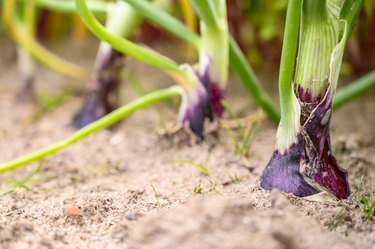
Let's face it – onions (Allium cepa) stink, and their flavors are, well, strong. So, it's tough to imagine what garden vegetable pests might be interested in eating onions, chives, shallots and leeks. Overall, Alliums are a hardy lot and are resistant to most marauders, but a few bogeys are out there waiting for you to turn your back long enough to fetch a cup of coffee so they can devastate your precious onion crop before you return. You're not unarmed, however. You can fight the most common onion pest threats without harming your kids, your pets or the environment.
When Beggars Are Choosers
Video of the Day
Aside from humans, who are notoriously adaptable in their food choices, insects are the only noteworthy pests of Alliums. This is only logical since the whole point of onions' pungent chemical arsenal is to deter animals from eating them.
Video of the Day
Although it may be anecdotal at best, some gardeners will tell you that the occasional starving deer may take a hesitant test mouthful of your onion plants here or there. What is known is that given nearly any other plant choice, even hungry, indiscriminate deer will pick fries over onion rings any day of the week.
Cutworms – Edward Scissorhands of Garden Pests
Cutworm (Feltia subterranea) damage is fairly easy to recognize. As the common name suggests, the cutworm cuts seedlings in two, killing the baby plant. This nocturnal vandal steals into the garden under cover of darkness, encircles an onion seedling's tender young stem at the soil surface and chews the plant in half.
Cutworms aren't fussy either – nearly any garden vegetable whose stem is smaller than pencil diameter is a potential food source. They're all-season pests too – cutworms are active in spring, summer, fall and winter. The good news is that once the plant outgrows babyhood, it typically outgrows its susceptibility to cutworm damage.
As onion-eating insects go, cutworms are fairly easy to eliminate without toxic chemicals. The best way to combat them is with physical barriers. Create "cutworm collars" yourself on the cheap. For small seedlings, toilet paper rolls are ideal. Simply slip a roll over the seedling and press it down a couple of inches into the soil. Take care not to injure delicate stems and leaves during the process. Cutworms won't be able to access the plant once a collar is in place. For larger seedlings, cut strips of lightweight cardboard from cereal or pasta boxes and fashion collars from those. You can also try cutting off the top and bottom of a soda can.
Onion Thrips – Green Onion Pests
The onion thrip (Thrips tabaci) is a very tiny onion-eating insect only 1 to 2 millimeters long and virtually invisible to the untrained human eye. They thrive in hot, dry weather. While there aren't any "specialized" pests of green onions, onion thrips are the most likely to be victimizing your onion greens or your green onions. Onion thrips damage appears as brown or tan spots or mottling on leaf surfaces as leaf cells die. Serious vectors of plant diseases, thrips have no problem spreading the wealth. They are easily transferred from one location to another via new plant introductions to your garden.
The absolute best ammunition for combating onion thrips is the preservation of their natural enemies, including predatory thrips, lady beetles, big-eyed bugs, minute pirate bugs and lacewing larvae. Planting flowers nearby to provide shelter, nectar and pollen for the natural enemies of thrips encourages them to hang around and patrol your garden area.
To protect your best weapon, avoid using toxic chemicals. Most pesticides decimate natural predators. Spinosad is a selective insecticide that not only offers good efficacy for controlling onion thrips but carries a low risk of toxicity to their natural predators.
Onion Maggots – Root and Bulb Feeders
Tiny brown-gray adult onion maggot flies (Delia antiqua) are only 5 to 7 millimeters long but fly up to a mile in their quest for host plants. The eggs of these onion pests thrive best in moist, cool ground. Larvae, or maggots, feed on onion stems, roots and bulbs as they develop, often decimating the plant's entire root system.
Predatory ground beetles are important biological controls for onion maggots, consuming the pest's eggs, larvae and pupae. Because these predators are among the best weapons for fighting this pest, utilize control measures that are safe for them. Spinosad, Bacillus thuringiensis (BT), neem and soap are all effective low-toxicity materials for controlling onion maggots without killing these valuable predators.